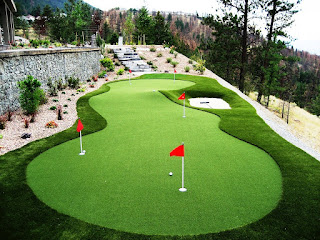Practicing on a driving range is good - proper practice is essential! No one wants to ingrain bad habits into the golf swing or into your round; they're so difficult to break! Instead, when you are alone with your golf clubs and no pro in sight, practice your lessons and keep these tips in mind:
 1. Just because you are practicing on a range doesn't mean you shouldn't first warm up your body - stretching before you begin will help improve the fluidity of your swing and, chances are, you won't pull a ligament or tendon.
1. Just because you are practicing on a range doesn't mean you shouldn't first warm up your body - stretching before you begin will help improve the fluidity of your swing and, chances are, you won't pull a ligament or tendon.2. Get your tempo down before you start swinging - practice tempo either with a training aid or think "1, 2, 3" (like a waltz) to the top of your back swing and then again "1, 2, 3" to the finish. Also, try holding your position at the top for a sec before your downswing - this will slow you down and improve your rhythm.
3. Practice a comfortable hold on your grip - if you're holding on too tight it can cause a pull hook and callouses on your fingers. If you have problems with your grip pressure, there are grips that you don't play with but can help properly align your hands and fingers.
4. You're not John Daly so don't practice with a "grip it and rip it mentality"- there's no need to take a mighty swing every time. Instead, start your routine with quarter and half swings to improve ball contact. And, since golf is a target sport, pick the smallest specific target you're aiming at before you take your practice swing. Practice your visualization - how you look at a hole and the course.
5. Make sure you spend some time each session on the putting green - practice your putting stroke which is the beginning of your golf swing so you can see and hear the ball fall into the cup.
What practice tips can you share? Share on Twitter @Golf4Beginners and on this golf blog.
photo: en.wikipedia.org, Golf for Beginners



